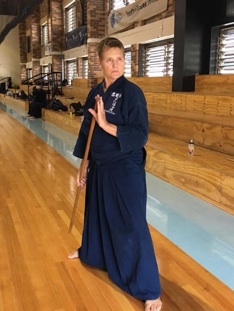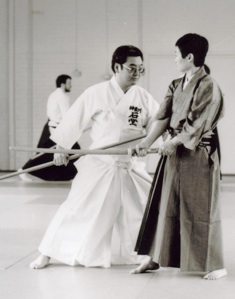Overview
Jodo is a Japanese martial art of the stick or short staff (Jo). The jo is 127.5cm in length (4 shaku, 2 sun, 1 bu) and 2.4cm in thickness and is usually made of Japanese white oak. In general practice, the jo is used against a bokken (wood training sword) in a paired kata training regime.
Curriculum
We follow the Tokyo line of Shindo Muso Ryu Jo as taught by Ishido Shizufumi Sensei, Kyoshi Hachidan (8th Dan) of Kanagawa prefecture in Japan. We are also very privileged to have yearly visits and seminars in Perth by Otake Toshiyuki Sensei, Kyoshi Hachidan (8th Dan) also of Kanagawa Ken.
Jodo training consists of three main areas of focus:
-
•Tandoku dosa – solo practice of basic techniques with the
jo
• Sotai dosa – paired practice of basic techniques with the jo against the sword
• Kata – paired forms of Jo usually against the sword
To the untrained eye, it appears that the purpose of the art is for the stick (jo) to beat the sword. Nothing could be further from the truth. Those that begin to train in Jodo quickly discover that the development of skills required to manoeuvre a sword are just as critical as those required to gain competence with the jo. In Jodo, necessary jo skills are developed through the mutual challenge of the Uchidachi (swordsperson) against the Shijo ( jo wielding person). It is this interrelation between the Uchidachi and the Shijo that provides for mutual progression in physical health, mental versatility and emotional strength.
Jodo originated out of the conglomeration of several weapon styles, combining techniques originating from the sword, spear, staff and halberd, to create movements of striking, thrusting, catching, trapping, throwing, blocking, sweeping, locking and subduing. For this reason the curriculum is quite broad, both in technical diversity and in number of forms taught. In addition to developing skills necessary when using a jo, , sword skills are further developed through the role of the Uchidachi, as the student is required to constantly learn and improve their kenpo (sword methodology). As such, the Uchidachi learns the correct techniques of cutting (from a variety of positions and angles), thrusting and blocking.
Jodo at a practical level teaches versatility and flexibility with the various weapons within the curriculum.
Within the ZKR affiliated associations, newcomers to Jodo learn ZKR Jodo Seiteigata - a set of twelve basic forms upon which examinations and competitions are based. More advanced students may learn the classical style (koryu) of Shindo Muso Ryu Jodo (or Jojutsu). The Shindo Muso Ryu Jodo curriculum contains numerous katas set out across various teaching sets. Further into curriculum, one learns the kata of auxiliary weapon systems such as sword vs. sword kenjutsu, tanjo (the short stick) and jutte (the truncheon).





